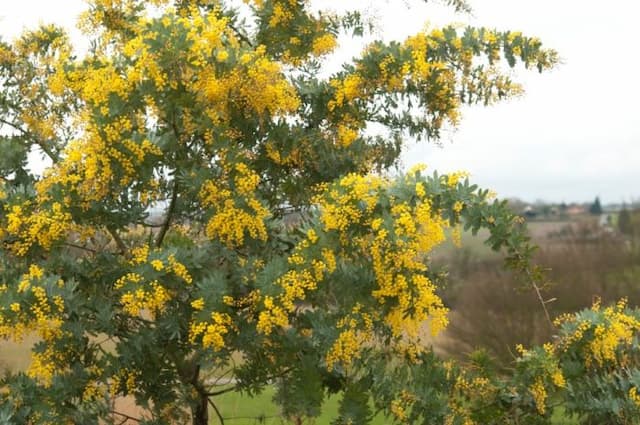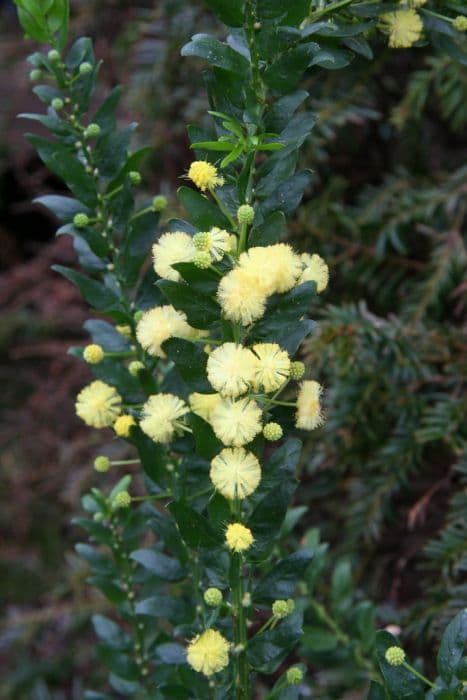Eastern Redbud Cercis canadensis Lavender Twist = 'Covey'
![redbud [Lavender Twist]](/_next/image?url=https%3A%2F%2Fplants-admin.emdemapps.com%2Fimages%2Fplants%2F%2Fimages%2F604b588683737.png&w=3840&q=75)
ABOUT
Lavender Twist, commonly known as the 'Covey' redbud, is a cultivar notable for its unique growth habit and charming spring display. The branches of this redbud arc and twist gracefully, creating a weeping effect that adds a sense of movement and elegance to the plant's structure. In early spring, before the foliage emerges, Lavender Twist is adorned with an abundance of small, delicate, lavender-pink flowers that envelop its cascading branches, offering a stunning floral spectacle. The blossoms are pea-like in shape, a characteristic of the redbud species, and they densely cluster along the plant's bare gray-brown wood. As the flowering season concludes, heart-shaped leaves emerge, transforming the plant with a lush, green canopy. These leaves may start out as a reddish color, gradually transitioning to a lighter green as they mature. In autumn, the foliage can show a range of colors from yellow to green, providing seasonal interest even after the flowers have faded. The contrast between the weeping branches and heart-shaped leaves creates a compelling visual texture that persists throughout the growing season. Lavender Twist redbud, with its distinctive form and captivating beauty, serves as an eye-catching focal point in garden settings, adding a touch of whimsy and charm to the landscape.
About this plant
 Names
NamesFamily
Fabaceae.
Synonyms
Eastern Redbud, American Redbud, Judas Tree, Lavender Twist Redbud.
Common names
Cercis canadensis 'Covey'.
 Toxicity
ToxicityTo humans
The plant known as Eastern Redbud is not known to be toxic to humans. Consequently, ingestion of this plant typically does not result in poisoning or adverse symptoms.
To pets
Eastern Redbud is generally considered non-toxic to pets as well. It is not associated with causing poisoning or harmful effects if pets ingest parts of this plant.
 Characteristics
CharacteristicsLife cycle
Perennials
Foliage type
Deciduous
Color of leaves
Green
Flower color
Pink
Height
5 feet (1.5 meters)
Spread
8 feet (2.4 meters)
Plant type
Tree
Hardiness zones
5
Native area
North America
Benefits
 General Benefits
General Benefits- Ornamental Appeal: 'Covey' adds aesthetic value to gardens with its unique weeping form, heart-shaped leaves, and stunning lavender-pink blooms that appear in spring before the foliage.
- Wildlife Attraction: The flowers provide nectar for pollinators such as bees and butterflies, enhancing biodiversity in the garden.
- Shade Provider: Despite its small stature, mature 'Covey' trees offer dappled shade, making them suitable for planting in small yards or gardens.
- Seasonal Interest: This cultivar offers year-round interest with flowers in spring, lush green foliage in summer, and attractive seed pods and leaf color changes in the fall.
- Compact Size: Reaching only 4-10 feet high, it is well-suited for small gardens or as a focal point in larger landscapes without overwhelming the space.
- Urban Tolerant: 'Covey' is adaptable to various urban conditions, including pollution and compacted soils, making it appropriate for city environments.
- Low Maintenance: Once established, this redbud variety requires minimal care, making it ideal for gardeners looking for low-maintenance landscaping options.
- Privacy Screen: When planted in groups, it can create a natural, living screen for enhanced privacy without using traditional fencing.
 Medical Properties
Medical PropertiesThis plant is not used for medical purposes.
 Air-purifying Qualities
Air-purifying QualitiesThis plant is not specifically known for air purifying qualities.
 Other Uses
Other Uses- As a natural art medium: Branches from the Eastern Redbud can be used in floral arrangements or as a canvas for air plant displays due to their unique twisted shape.
- Educational purposes: Schools and botanical gardens often use Eastern Redbud 'Covey' to teach about plant genetics and the development of cultivars.
- Bonsai cultivation: With proper pruning, the Eastern Redbud 'Covey' can be trained into a striking bonsai tree, making it popular among bonsai enthusiasts.
- Landscape architecture models: The small and intricate branching pattern of the 'Covey' can be used to create miniature landscape models.
- Seasonal decorations: Its branches can be collected and painted for use in seasonal wreaths and ornaments.
- Photography prop: The distinctive twisted branches and pink flowers make it an attractive prop for photographers, especially during spring.
- Nature-inspired design: Artists and designers might use the tree as inspiration for furniture or architectural elements due to its twisting form.
- Eco-friendly dye: Although not commonly used, the flowers could potentially be used to produce a natural dye for textiles.
- Crafting material: Dried seed pods from the Eastern Redbud could be used in crafting, such as making homemade jewelry or decorative items.
- Urban greening projects: 'Covey' can be used in urban areas to create visually engaging green spaces that support biodiversity.
Interesting Facts
 Feng Shui
Feng ShuiThe Eastern Redbud is not used in Feng Shui practice.
 Zodiac Sign Compitability
Zodiac Sign CompitabilityThe Eastern Redbud is not used in astrology practice.
 Plant Symbolism
Plant Symbolism- Renewal and Rebirth: 'Covey', also known as the Eastern Redbud tree, often symbolizes renewal and rebirth because it is among the first trees to flower in spring.
- Love: The heart-shaped leaves of Eastern Redbud are sometimes associated with love and compassion.
- Hope: With its vibrant early blooms, the Eastern Redbud can symbolize hope, representing the promise of new beginnings.
- Beauty: The striking appearance of the Lavender Twist redbud, with its contorted branches and pink flowers, is often linked to beauty and the appreciation of unique natural forms.
 Water
WaterThe Eastern Redbud 'Covey', also known as Lavender Twist, should be watered deeply once a week, with about 1 to 1.5 gallons of water for young trees, increasing to 2 to 3 gallons for established trees. During the first growing season, ensure consistent moisture to establish a deep, extensive root system, watering twice a week if there isn't sufficient rain. Reduce the watering frequency once the tree is established, but water more often in extreme heat or drought. Avoid overhead watering to minimize the risk of disease.
 Light
LightEastern Redbud 'Covey' flourishes in a location with full sun to partial shade. The ideal spot is one that receives morning sunlight and some afternoon shade, especially in hotter climates. Avoid deep shade as it may reduce the flowering and can lead to a leggy growth habit.
 Temperature
TemperatureEastern Redbud 'Covey' is hardy in USDA zones 5 through 9 and can withstand winter temperatures as low as -20°F and is heat tolerant up to around 90°F. The ideal temperature conditions for this plant are between 60°F and 85°F, which allows for optimal growth and flowering.
 Pruning
PruningPrune Eastern Redbud 'Covey' in late winter or early spring before new growth starts to remove any dead or broken branches and to maintain its shape. This weeping variety typically requires minimal pruning, just enough to enhance its natural form or to remove any growth issues. It is best to prune immediately after flowering if shaping is required, as this species blooms on old wood.
 Cleaning
CleaningAs needed
 Soil
SoilEastern Redbud 'Lavender Twist' thrives in well-draining soil with a pH of 5.5 to 7.5. The best soil mix for optimal growth consists of loamy soil supplemented with compost and peat for moisture retention and nutrient richness. It is crucial to ensure the soil has good drainage to prevent waterlogging which can lead to root rot.
 Repotting
RepottingThe Eastern Redbud 'Lavender Twist' is typically planted directly in the ground and does not require repotting as it is a tree. However, if grown in a container, repotting should be done every 2-3 years or when the tree outgrows its pot, monitoring root development as the indicator for repotting.
 Humidity & Misting
Humidity & MistingEastern Redbud 'Lavender Twist' is adaptable to a wide range of humidity conditions. It can thrive in the variable humidity levels found in typical outdoor environments, without any specific humidity requirements, making it versatile for different garden settings.
 Suitable locations
Suitable locationsIndoor
Not ideal for indoor growing due to its size.
Outdoor
Plant in well-draining soil, full sun to partial shade.
Hardiness zone
5-9 USDA
 Life cycle
Life cycleEastern Redbud 'Covey' (Lavender Twist) begins its life as a dormant seed, which requires stratification to mimic winter conditions before it will germinate. Upon germination, the seedling grows into a small shrub, establishing a root system and foliage. As it matures into a juvenile plant, it forms a distinctive twisted, weeping habit, for which it is known, and begins to produce heart-shaped leaves. During its reproductive stage, likely a few years after planting, it blooms early in the spring with clusters of lavender-pink flowers before the foliage emerges, which are pollinated by insects. After flowering, it produces flat, bean-like seed pods that persist into winter. As a woody perennial, the Eastern Redbud 'Covey' can live for many years, going through repeated cycles of dormancy in winter, flowering in the spring, and seed production in the summer to fall.
 Propogation
PropogationPropogation time
Early spring
The Eastern Redbud 'Lavender Twist' (Cercis canadensis 'Covey') is most commonly propagated by grafting. This process involves taking a scion, which is a cutting from a mature 'Lavender Twist' tree that includes a bud, and joining it to a compatible rootstock. Grafting is usually performed during the late winter or early spring before the sap starts to flow. The scion should be around 4 to 6 inches (approximately 10 to 15 centimeters) in length, and it is attached to a rootstock of another Cercis species or variety that is known for its vigorous growth and hardiness. The connection point is carefully wrapped and sealed to prevent desiccation and infection, allowing the scion and rootstock to fuse as they grow. This method maintains the distinct weeping and twisted growth habit and flower color of the 'Lavender Twist' while taking advantage of the hardiness of the rootstock.









